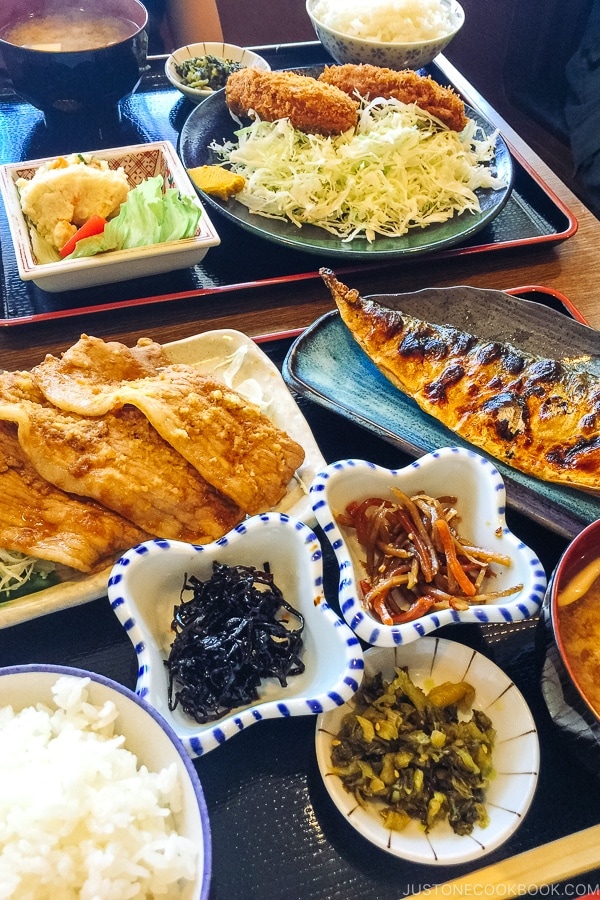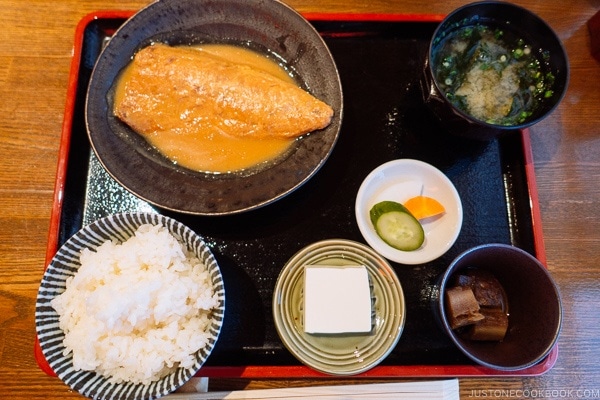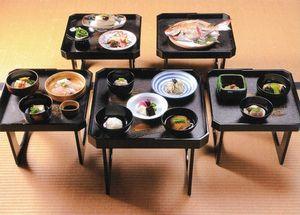Curious what the Japanese eat everyday or want to plan a full out Washoku meal? The mystery is all in One Soup Three Dishes called “Ichiju Sansai” (一汁三菜)

Korokke Teishoku and Ginger Pork Teishoku with a side order of Grilled Mackerel.
Thanks to Japanese food porn shows such as Midnight Diner: Tokyo Stories (Shinya Shokudo 深夜食堂) and The Solitary Gourmet (Kodoku no Gourmet 孤独のグルメ), we receive many questions from curious readers about the dishes featured on the shows (Nami has an entire section of recipes on Midnight Diner Recipe Series). But most interesting were the questions like “What do the Japanese eat every day?” and “How can I plan and cook Japanese food at home?”
Contrary to popular belief, the Japanese do not live off a steady diet of ramen, sushi, and tempura (although I wish!). Japanese cuisine/Washoku is actually quite simple and a nutritious balance of protein and vegetables served each in its own plates and bowls.
Called Ichiju Sansai (一汁三菜), literally “one soup three dishes,” this is the foundation of a Japanese meal.

Tempura & Takikomi Gohan (Mixed Rice) Teishoku (Set Meal)
What is Ichiju Sansai?
A typical Japanese meal is composed of four elements: rice, soup, side dishes and pickled vegetables.
- Gohan (ご飯) – a bowl of plain steamed rice
- Shiru (汁) – a bowl of soup, which may contain vegetables or tofu
- Okazu (おかず) – three side dishes, composed of vegetables, tofu, fish or meat
- Kouno mono(香の物) – a small plate of pickled seasonal vegetables
This meal format can be served for breakfast, lunch or dinner. If you’ve been fortunate to spend a night at a ryokan (Japanese inn), you may have witnessed the elaborate spread of dishes for breakfast. Or perhaps you may have encountered something similar in the form of a teishoku (set meal on a tray) at Ootoya Restaurant (the Japanese chain restaurant) or other places.

Saba Misoni Teishoku (set meal)
Ichiju Sansai – Where Did It All Begin?
 The style of “one soup three dishes” originates from Honzen Ryori (本膳料理), a highly refined system of meal-serving that was established as a banquet style of the upper nobility and the samurai class during the Muromachi period (1336–1573).
The style of “one soup three dishes” originates from Honzen Ryori (本膳料理), a highly refined system of meal-serving that was established as a banquet style of the upper nobility and the samurai class during the Muromachi period (1336–1573).
The elaborate dishes were arranged and brought to the guests on small four-legged tray tables called “zen” (膳). The tables would be presented to the guests in sets of three, five, or seven, starting with the main “zen” (Hon-zen 本膳), second “zen” (Nino-zen 二の膳), third “zen” (Sanno-zen 三の膳) and so forth.
The style of honzen ryori simplified over time from the extravagance to the everyday meal, and what remains to this day are the dishes on the main “zen” (Hon-zen), featuring rice, soup, pickles and three okazu dishes. This is the foundation of “one soup three dishes.”

Rice in the Heart of Japanese Cuisine
Wondering why there’s no mention of rice or pickles in the Ichiju Sansai (One Soup Three Dishes) setup? This is because rice and pickled vegetables are always included in a Japanese meal. Rice is not only a dish in itself, but it is also an essential component in the national cuisine.
It also has a symbolic place in the Japanese language: the term Gohan (ご飯) means both “cooked rice” and “meal.” The sticky short-grain Japonica rice is the heart of a Japanese meal, and also the staff of life.
It’s also a necessary ingredient in Japanese cuisine. Koji (麹) mold culture injected into steamed rice is an essential ingredient in making Sake, Mirin and Miso.

Plan an ‘Ichiju Sansai’ Meal
So let’s get started! Ichiju Sansai is just a structure, so even if you’re vegetarian, pescatarian, vegan or have dietary restrictions, you can easily swap and adjust recipes to suit your dietary needs for a filling meal.
Browse through the recipes below to pick out what you want to cook!
Rice (Gohan)
Traditionally, rice would be served plain. But if you’re seeking for flavor and color in your rice, try Takikomi Gohan (炊き込みご飯), rice cooked with vegetables and seasonings.
Here’s a list of ideas to get you started:
- How to Cook Rice (if you don’t own a rice cooker!)
- Ginger Rice (with a little spicy kick!)
- Gobo and Miso Takikomi Gohan (add oomf to your rice with burdock root and fish cake)
- Mame Gohan (fresh spring peas cooked with rice)
- Matsutake Gohan (an autumn delicacy)
- Chestnut Rice (another autumn specialty)
- Sweet Onion Takikomi Gohan (sweet sautéed onions cooked with rice)
Pickled vegetables (Tsukemono)
Cleansing your palate between a meal may sound a little strange at first, but with all the different textures and flavors going on, it’s actually refreshing to reset your mouth from time to time.

Karaage Teishoku (Set Meal)
Soup (Shiru)
A soup is not just a side dish, but it holds its own place in a Japanese meal. Miso soup is most commonly served, but feel free to serve whatever you wish!
- Miso Soup (your everyday soup)
- Japanese Clam Soup with Clear Broth (a simple clear broth with kombu dashi and Manila clams)
- Kenchinjiru (a hearty vegan soup)
- Matsutake Soup (a clear broth, featuring an autumn delicacy)
- Sanpeijiru (originally from Hokkaido, a chunky salmon soup)
- Tonjiru (a pork and root vegetable miso stew)
Side Dishes (Okazu)
As eating meat became popularized only during the last 150 years, traditionally the main protein would be fish, either grilled or simmered. But nowadays, you’ll see fried foods such as Tonkatsu or Karaage, or even Gyoza as the main protein.
Meat & Fish dish
- Kakuni (braised pork belly)
- Catfish Kabayaki
- Hamachi Kama
- Nikujaga (potato and pork braise)
- Ootoya’s Sweet and Sour Chicken (vegetable and chicken stir-fry)
- Saba Misoni (mackerel poached in miso)
- Tonteki (pork loin)
- Yellowtail Teriyaki
Vegetable dish
Vegetables are served in cooked form and not served raw.
- Agedashi Tofu (deep fried tofu cubes)
- Broccolini Gomaae (dressed in a nutty sesame sauce)
- Hijiki Seaweed
- Kinpira Renkon (stir-fried lotus root)
- Simmered Kabocha
- Spinach Ohitashi (blanched spinach in dashi)
- Vegetable Tempura
- Warm Mushroom Salad
Ichiju Sansai is just a format, so don’t worry if your meal doesn’t look perfect with all the correct number of dishes. The point is to have a well-balanced meal of protein, vegetables and carbohydrates.
Lastly, please let us see of your Ichiju Sansai meals by posting your photos on Instagram with the hashtag #justonecookbook!

Check out our other Japan categories: Washoku 101 and All Things Japanese!
Sign up for the FREE Just One Cookbook newsletter delivered to your inbox! And stay in touch with me on Facebook, Google+, Pinterest, and Instagram for all the latest updates.

Kayoko happily grew up in the urban jungle of Tokyo and in the middle of nowhere East Coast, U.S. After a brief stint as a gelato scooper and a slightly longer employment at an IT company, she decided to drop her cushy job to enroll in culinary school. Kayoko resides in Tokyo with her husband, a penguin pillow, and many half-dead plants. More from Kayoko →
The post Plan a Japanese Meal: One Soup Three Dishes “Ichiju Sansai” (一汁三菜 ) appeared first on Just One Cookbook.
from Merah Hati Cintaku http://ift.tt/2F3BcDO
via merahhaticintaku.blogspot.my
No comments:
Post a Comment